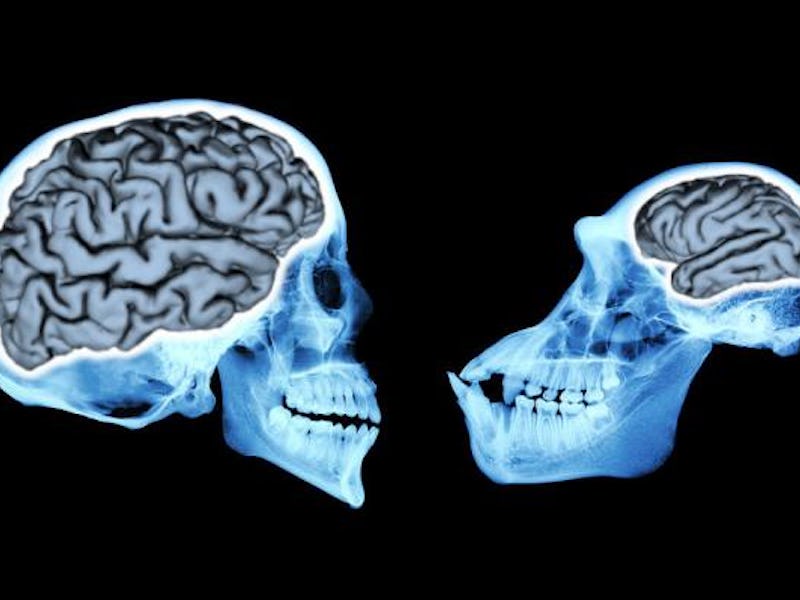Scientists Uncover the 3 Evolutionary Factors That Made Human Brains So Big
There is "no clear link between brain size and behavior."

The human brain is three pounds of incredible power. A mass of supportive tissues and nerves, it controls how we feel, move, hear, talk, and remember. When you consider our brain-to-body mass ratio, our brains are also quite big — three times larger than the brains of our primate cousins, the chimpanzees and bonobos.
Scientists have not been able to figure out what drove our brains to become so much larger than those of our closest living relatives. Some have theorized that eating meat and using tools contributed to brain growth, but those explanations never fully explained how human brain size doubled over the past 3 million years. Now, in Proceedings of the Royal Society B, scientists present a new idea.
These are models of human ancestor brain size compared to modern day humans.
In the paper released Tuesday, scientists from George Washington University argue that brain size increased because of three major factors: evolution within hominin populations, the introduction of larger-brained species, and the extinction of smaller-brained ones. The team came to this conclusion by analyzing the skull volumes of 94 fossil specimens representing 13 different hominin species, which included the Australopithecus, one of the earliest human ancestors that lived 3.2 million years ago, and Homo erectus, which existed 500,000 years ago. With Homo erectus, a fairly recent member of the Homo family tree, brain size began to overlap with the size that human brains are today.
Comparing the skull sizes of individuals that descended from a common ancestor showed that average brain size increased gradually rather than abruptly. Modern human brain size, the authors write, is largely a result of the steadily growing brain size of increasingly modern species, while the survival of larger-brained species (like Homo erectus) also significantly contributed to larger brains becoming the human norm.
It’s a little like building a strong roster of football players, say the authors. While some of the guys will get bigger by working out, the smaller players can also be replaced by newly recruited larger guys.
The human brain grew gradually to get to the size it is today.
“Brain size is one of the most obvious traits that makes us human,” co-author Andrew Du, Ph.D., explains in a statement released Tuesday. “It’s related to cultural complexity, language, tool making, and all these other things that make us unique. The earliest hominins had brain sizes like chimpanzees, and they have increased dramatically since then.
Du’s advisor, Bernard Wood, Ph.D., also notes that this study negates the idea that brain size got bigger because of specific decisions our ancestors made and asserts there is “no clear link between brain size and behavior.” While it seems unlikely that our own brains will continue to grow in size — we already have brain folds because they barely fit in our skulls — it remains to be seen how modern behavior will influence our intelligence. Our big brains help with our smarts, but some argue that augmented brains will take us to a whole other level — one that’s not confined by evolution.